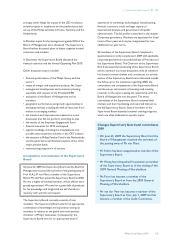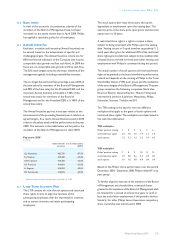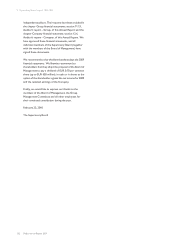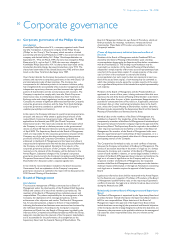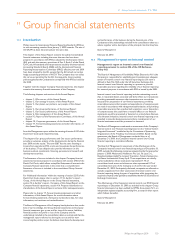Philips 2009 Annual Report Download - page 143
Download and view the complete annual report
Please find page 143 of the 2009 Philips annual report below. You can navigate through the pages in the report by either clicking on the pages listed below, or by using the keyword search tool below to find specific information within the annual report.10 Corporate governance
10.1 Corporate governance of the Philips Group
Introduction
Koninklijke Philips Electronics N.V., a company organized under Dutch
law (the ‘Company’), is the parent company of the Philips Group
(‘Philips’ or the ‘Group’). The Company, which started as a limited
partnership with the name Philips & Co in 1891, was converted into the
company with limited liability N.V. Philips’ Gloeilampenfabrieken on
September 11, 1912. On May 6, 1994, the name was changed to Philips
Electronics N.V., and on April 1, 1998, the name was changed to
Koninklijke Philips Electronics N.V. Its shares have been listed on the
Amsterdam Stock Exchange, Euronext Amsterdam, since 1913. The
shares have been traded in the United States since 1962 and have been
listed on the New York Stock Exchange since 1987.
Over the last decades the Company has pursued a consistent policy to
enhance and improve its corporate governance in line with Dutch, US
and international (codes of) best practices. The Company has
incorporated a fair disclosure practice in its investor relations policy,
has strengthened the accountability of its executive management and its
independent supervisory directors, and has increased the rights and
powers of shareholders and the communication with investors. The
Company is required to comply with, inter alia, Dutch Corporate
Governance rules, the US Sarbanes-Oxley Act, New York Stock
Exchange rules and related regulations, insofar as applicable to the
Company. A summary of significant differences between the Company’s
corporate governance structure and the New York Stock Exchange
corporate governance standards is published on the Company’s
website (www.philips.com/investor).
In this report, the Company addresses its overall corporate governance
structure and states to what extent it applies the provisions of the
revised Dutch Corporate Governance Code of December 10, 2008
applicable to the financial year 2009 (the ‘Dutch Corporate
Governance Code’). This report also includes the information which
the Company is required to disclose pursuant to the governmental
decree on Article 10 Takeover Directive and the governmental decree
of April 2009. The Supervisory Board and the Board of Management,
which are responsible for the corporate governance structure of the
Company, are of the opinion that the principles and best practice
provisions of the Dutch Corporate Governance Code that are
addressed to the Board of Management and the Supervisory Board,
interpreted and implemented in line with the best practices followed by
the Company, are being applied. Deviations from aspects of the
corporate governance structure of the Company, when deemed
necessary in the interests of the Company, will be disclosed in the
Annual Report. Substantial changes in the Company’s corporate
governance structure and in the Company’s compliance with the Dutch
Corporate Governance Code are submitted to the General Meeting of
Shareholders for discussion under a separate agenda item.
In line with the recommendation included in the Dutch Corporate
Governance Code an explanation of the Company’s corporate
governance structure as outlined in this report will be discussed at the
2010 General Meeting of Shareholders.
10.2 Board of Management
Introduction
The executive management of Philips is entrusted to its Board of
Management under the chairmanship of the President/Chief Executive
Officer and consists of at least three members (currently six). The
members of the Board of Management have collective powers and
responsibilities. They share responsibility for the management of the
Company, the deployment of its strategy and policies, and the
achievement of its objectives and results. The Board of Management
has, for practical purposes, adopted a division of responsibilities
indicating the functional and business areas monitored and reviewed by
the individual members. According to the Company’s corporate
objectives and Dutch law, the Board of Management is guided by the
interests of the Company and its affiliated enterprises within the Group,
taking into consideration the interests of the Company’s stakeholders,
and is accountable for the performance of its assignment to the
Supervisory Board and the General Meeting of Shareholders. The
Board of Management follows its own Rules of Procedure, which set
forth procedures for meetings, resolutions, minutes and (vice-)
chairmanship. These Rules of Procedure are published on the
Company’s website.
(Term of) Appointment, individual data and conflicts of
interests
Members of the Board of Management and the President/CEO are
elected by the General Meeting of Shareholders upon a binding
recommendation drawn up by the Supervisory Board after consultation
with the President/CEO. This binding recommendation may be
overruled by a resolution of the General Meeting of Shareholders
adopted by a simple majority of the votes cast and representing at least
one-third of the issued share capital. If a simple majority of the votes
cast is in favor of the resolution to overrule the binding
recommendation, but such majority does not represent at least one-
third of the issued share capital, a new meeting may be convened at
which the resolution may be passed by a simple majority of the votes
cast, regardless of the portion of the issued share capital represented by
such majority.
Members of the Board of Management and the President/CEO are
appointed for a term of four years, it being understood that this term
expires at the end of the General Meeting of Shareholders to be held in
the fourth year after the year of their appointment. Reappointment is
possible for consecutive terms of four years or, if applicable, until a later
retirement date or other contractual termination date in the fourth
year, unless the General Meeting of Shareholders resolves otherwise.
Members may be suspended by the Supervisory Board and the General
Meeting of Shareholders and dismissed by the latter.
Individual data on the members of the Board of Management are
published in chapter 8, Our leadership, of this Annual Report. The
acceptance by a member of the Board of Management of membership of
the supervisory board of another company requires the approval of the
Supervisory Board. The Supervisory Board is required to be notified of
other important positions (to be) held by a member of the Board of
Management. No member of the Board of Management holds more
than two supervisory board memberships of listed companies, or is a
chairman of such supervisory board, other than of a Group company or
participating interest of the Company.
The Company has formalized its rules to avoid conflicts of interests
between the Company and members of the Board of Management. The
articles of association state that in the event of a legal act or a lawsuit
between the Company and a member of the Board of Management,
certain of such member’s relatives, or certain (legal) entities in which a
member of the Board of Management has an interest, and insofar as the
legal act is of material significance to the Company and/or to the
respective member of the Board of Management, the respective
member of the Board of Management shall not take part in the decision-
making in respect of the lawsuit or the legal act. Resolutions concerning
such legal acts or lawsuits require the approval of the Supervisory
Board.
Legal acts as referred to above shall be mentioned in the Annual Report
for the financial year in question. The Rules of Procedure of the Board
of Management establish further rules on the reporting of (potential)
conflicts of interests. No legal acts as referred to above have occurred
during the financial year 2009.
Relationship between Board of Management and Supervisory
Board
The Board of Management is supervised by the Supervisory Board and
provides the latter with all information the Supervisory Board needs to
fulfill its own responsibilities. Major decisions of the Board of
Management require the approval of the Supervisory Board; these
include decisions concerning (a) the operational and financial objectives
of the Company, (b) the strategy designed to achieve the objectives, (c)
if necessary, the parameters to be applied in relation to the strategy and
(d) corporate social responsibility issues that are relevant to the
Company.
10 Corporate governance 10 - 10.2
Philips Annual Report 2009 143




